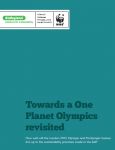WWF-UK and BioRegional find that most of the promises made in the London 2012 sustainability strategy will be met.
RTCC's mini-audit of some of the venues of the Olympics finds that generally, the venues meet the sustainability measures put in place, with the construction of the venues producing fewer carbon emissions than expected.
The real test of sustainability, RTCC says, is what happens to the venues after the Games.
 July 2012: WWF-UK, BioRegional and Responding to Climate Change (RTCC) have undertaken studies of the London 2012 Olympic Games to ascertain how sustainable it will be. They conclude that it will be the “greenest” Olympic Games to date, and plan to continue to observe sustainability measures following the Games.
July 2012: WWF-UK, BioRegional and Responding to Climate Change (RTCC) have undertaken studies of the London 2012 Olympic Games to ascertain how sustainable it will be. They conclude that it will be the “greenest” Olympic Games to date, and plan to continue to observe sustainability measures following the Games.
In their report, titled “Towards a One Planet Olympics Revisited,” WWF-UK and BioRegional consider whether the London 2012 Olympics will deliver on the 76 promises made in “Towards a One Planet Olympics,” the London 2012 sustainability strategy. This strategy formed part of London’s bid to host the Olympic Games and then part of London’s promise to ensure the sustainability of the Games. Using scorecards, the report rates these promises as follows: red, meaning the promise is off-track or has not been met; amber, meaning the promise has been partially met or is unclear; or green, meaning there is a high level of confidence that the promise will be met. The report concludes that most of the bid promises have been met, although there are some disappointments, such as the failure to achieve the renewable energy target.
WWF-UK and BioRegional will produce a follow-up report after the Games have taken place, containing a more detailed analysis of the Games’ sustainability.
RTCC undertook a mini-audit of some of the venues of the London 2012 Olympics, as well as the methods of transport provided and promoted, in order to investigate whether this Games will be the “greenest” Olympic Games ever. The study analyzed the architecture of four purpose-built venues – the Olympic Stadium, the Aquatics Centre, the Velodrome, and the Basketball Arena – as well as several existing areas being used in the Games, such as the Horse Guards Parade and Hyde Park. RTCC concludes that, generally, the venues meet the sustainability measures put in place, with the construction of the venues producing fewer carbon emissions than expected, and also coming in under budget and on time. According to RTCC, what happens to the venues after the Games will be the real test of sustainability.
The study also highlights one of the sustainable transport measures put in place: the provision of travelcards with all ticket purchases, to encourage spectators to travel to the Games venues via public transport instead of private vehicles. [Publication: Towards a One Planet Olympics Revisited] [RTCC Press Release]